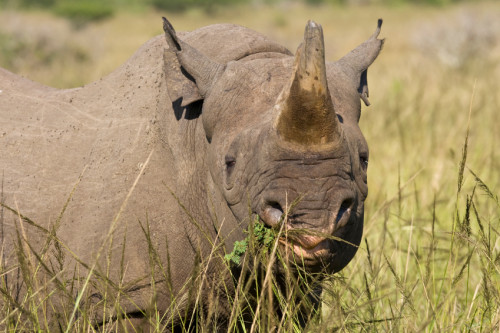
The United Nations Office on Drugs and Crime (UNODC) has published the first ever global assessment of wildlife crime.
The World Wildlife Crime Report validates years of warnings issued by NGOs and wildlife law enforcement officials by showing the extensive involvement of transnational organized criminal groups and the pervasive impact of corruption. (Download the full report.)
Eight case studies are featured in the report: rosewood logs, African elephant ivory, reptile skins, oud (agarwood), pangolins, rhino horn, live parrots, and caviar. The report also profiled illicit trade in Asian big cat skins, bear bile, great apes, freshwater turtles and tortoises, marine turtles, and glass eels.
“There is increasing recognition of the dangers wildlife and forest crime pose not only to the environment but to the rule of law and stability, and of the potential for the criminal proceeds to fuel conflict and terrorism. The desperate plight of iconic species at the hands of poachers has deservedly captured the world’s attention, and none too soon,” writes Yury Fedotov, UNODC Executive Director, in the report’s Foreword.
“We must stop the plundering or risk irreparable loss of our planet’s precious biodiversity. I urge all governments to make full use of this report and the support UNODC provides to take decisive steps towards ending this crime.”
A noteworthy policy change which was announced with the release of the report is the new requirement of CITES Parties to submit annual illegal trade reports – in addition to their annual and biennial reporting requirements – beginning in 2017. This data will form the foundation of “World WISE” – a global seizure database which is currently under development and already contains over 164,000 seizures from 120 countries.
Several of the ten key findings of the UNODC World Wildlife Crime Report implicate the use of legal trade loopholes:
- Wildlife trafficking is comprised of many distinct markets, each with its own drivers and dynamics;
- Illegally sourced wildlife is retailed through both illegal and legal outlets;
- When illegally traded wildlife is introduced into legal commercial streams, criminals have access to a much larger consumer base than if they depended on the illegal market;
- Millions of species can be legally traded internationally, despite national laws protecting these species;
- Fraudulent permits have been used to traffic wildlife;
- Most enforcement activities occur at ports of entry, thus customs agents form the front line of enforcement in many parts of the world;
- Internationally protected wildlife can be illegally introduced into commercial streams before being legally exported;
- Wildlife farms, captive breeding operations and some zoos may be involved with laundering illegally acquired wildlife;
- Demand reduction campaigns are compromised by speculation, in which price becomes detached from retail demand;
- It is extremely difficult to calculate criminal revenues associated with wildlife trafficking as a whole because certain species are affected by market volatility.
“The launch of the first ever World Wildlife Crime Report shows that the response to wildlife crime is coming of age,” said John E. Scanlon, Secretary-General of CITES.
“This comprehensive global report is rooted in the best data and case studies available, is backed by in-depth analysis, and demonstrates a heightened sense of rigor in the way in which we report on wildlife crime”.
Although many informational, legislative, and operational gaps were identified by the UNODC World Wildlife Crime Report, all of them have solutions:
- If all countries had national laws which prohibit possession of illegally acquired wildlife, illegal trade could be reduced;
- Domestic environmental laws should be expanded to protect wildlife from other parts of the world because current international trade controls do not extend into national markets;
- Research and monitoring should be further strengthened and used as the basis for conservation policy and enforcement strategy;
- The international community can support local law enforcement through technical assistance, capacity building and coordinating international operations;
- Strengthening criminal justice responses to wildlife crime in range countries should be supported by enhanced technical and financial assistance;
- In order to ensure supply chain integrity from source to destination markets, commercial traceability mechanisms should be strengthened;
- The active use of profiling and targeting suspicious shipments and persons should be mobilized and promoted;
- The use of wildlife forensic science should be increased in order to identify species and design targeted law enforcement responses;
- Further interdiction can be encouraged by mechanisms and procedures for disposal of seized wildlife products;
- Stockpile leakage into illegal trade can be prevented by proper stockpile management;
- Establishment of new protected areas should be supported by the international community;
- Illegal harvesting and trade can be reduced by implementing measures to prevent and combat corruption month rangers, wildlife investigators and other relevant officials;
- The United Nations Convention on Corruption should be utilized where public servants are implicated in facilitating wildlife trafficking.
The UNODC emphasizes that a thorough understanding of the main issues relating to wildlife crime *and* effective criminal justice responses at the national level are essential. Helpful tools such as the International Consortium on Combating Wildlife Crime (ICCWC) Wildlife and Forest Crime Analytic Toolkit and the ICCWC Indicator Framework for Wildlife and Forest Crime are suggested for use.
We at Annamiticus are hopeful that the key findings of this comprehensive analysis will serve as a catalyst for government officials and policymakers – as well as the general public and media – to take immediate, meaningful action to stop the global wildlife trafficking crisis.
Help fight against wildlife trafficking: Support our work to advocate for the protection of endangered species at the upcoming CITES CoP17 in South Africa.



![China’s Tiger Trade Conspiracy [Podcast]](https://annamiticus.com/wp-content/uploads/2015/12/BehindTheSchemesEpisode39-150x150.png)
![The UN’s Lone Ranger: Combating International Wildlife Crime [Podcast]](https://annamiticus.com/wp-content/uploads/2015/10/BehindTheSchemesEpisode37-500px-150x150.png)